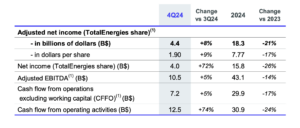
The energy transition sustained an electoral trauma as 2024 drew to a close. The incoming administration of President-elect Donald Trump promises to undo at least some of the progress made on decarbonization under President Joe Biden. But the energy market is its own beast, subject to politics but also beholden to economic, technological, environmental and international forces. Here are five elements to watch in Year One of Trump Two.
The IRA: Walking Dead or Walking Wounded?
Democrats entered 2021 debating how many trillions of dollars of subsidies would feature in a climate bill. Four years later, they brace for how much of the (shrunken) legislation that ultimately passed will survive.
Three things offer them grounds for cautious hope. First, Trump’s earlier trifecta, in his first term, didn’t deliver a death blow to the Affordable Care Act, a prior GOP bête noire. It’s just hard to remove federal benefits once enacted — which leads into the second factor: Cleantech investment and jobs spurred by the Inflation Reduction Act flow overwhelmingly to red districts. Thirdly, Republicans’ House majority is razor thin.
Some things, like electric vehicle customer tax credits and offshore wind-power support, look doomed. The same goes for regulatory struts, such as tighter fuel economy standards.
The upshot will be higher emissions, but also widespread uncertainty. A recent flurry of cleantech loans by the Department of Energy reflects a desire by the outgoing administration to cement investments before the political ground shifts against them. Companies must now navigate a murky path on exactly which bits of the IRA may go in the next year or two, and how things might swing back again after 2026 or 2028. After a surge in such spending over the past two years, 2025 will provide clues on whether private money targeting the energy transition saw the recent election as a speed bump or a wall.
Biden’s Green Boom
US investment in the manufacturing and deployment of emissions-reducing technologies, by segment
Musk Puts the Brakes on EVs
Having failed to cut $20,000 from the cost of making a car, Elon Musk is confident he can rip $2 trillion out of the federal budget.
None of that is good for EVs in the US. Reversing flagging sales growth in the country requires the arrival of much cheaper models such as the one Musk was touting less than two years ago. Instead, with Tesla Inc.’s valuation now overwhelmingly a function of Musk’s robotaxi utterances and proximity to Trump as cost czar, EV subsidies are for the chop.
The Electric Premium
Average transaction price of selected major US passenger vehicle categories, split by drivetrain
Foreknowledge of that could actually boost sales early in 2025, as the EV-curious rush to take advantage while they can. But next year as a whole will disappoint as cuts to federal support raise the price of existing EVs and slow the development of new ones. Besides Tesla’s still MIA “more affordable” models, Detroit has spent 2024 walking back its EV ambitions.
For Tesla itself, the big issue should be whether it actually puts some robotaxis on the roads, with Musk having re-upped his long-standing pledge at the company’s poorly received event in October. That said, Musk has deferred a reckoning on that for years. Plus, he now has a new, if vague, story to sell the faithful, centered on his potentially advantageous relationship with Trump — assuming the two of them can share the spotlight.
Politics vs. (Renewable) Power
In the battle over whether Democrats can force an energy transition by legislation and Republicans can, by the same token, prevent it, we can lose sight of underlying forces. Take renewable energy, where subsidies matter but so, too, do basic things like electricity demand.
A full repeal of federal tax credits for wind and solar power and batteries — while I think unlikely — would make those technologies significantly more expensive. The average cost of US grid-scale solar in 2025, for example, would rise from an estimated $58 per megawatt-hour to $72, according to Morgan Stanley. A sudden jump in energy procurement costs would make any buyer at least hesitate before signing up.
A related, and important, question is how badly that customer needs the power. The year closed with a crescendo of stories about Big Tech chasing any source of electricity to fuel an artificial intelligence arms race. Renewable energy, due to its intermittency, offers only a partial solution for data centers with 24×7 demand. Yet new nuclear power is at least a decade away and even new gas-fired plants commissioned today would take at least three to five years.
We will certainly see plans for new gas-fired plants accelerate in 2025. Equally, though, the sheer need for supply, and quickly, should mean even Trump cannot stop new renewables capacity, with its faster development schedules, being contracted. Reduced federal support would no doubt slow the pace. Although, as Bloomberg NEF points out, expectations of tax credits sunsetting could, paradoxically, pull forward demand and make 2025 a banner year for new projects.
With or Without Subsidies
Projected annual US installations of utility-scale solar, wind and battery capacity, in megawatts, under two scenarios
Hydropower Needs Free Rein
Long before solar panels or giant batteries, there was flowing water spinning turbines. More than a quarter of US renewable power generation in 2024 derived from hydroelectricity.
That was still the lowest absolute level of output since 2001. Drought is the immediate problem. The area of the US experiencing drier-than-normal conditions hit almost 88% in October, the highest level in going back to 2000. This being weather-related, forecasting is especially tricky. While the Energy Information Administration currently projects a 9% increase in hydropower output in 2025, it was similarly optimistic for 2024, when output ended up falling.
When hydropower dries up, natural gas tends to fill in (see the chart below). That’s partly because hydropower offers some of the same flexibility to back up wind and solar power that gas turbines provide; making it not just a source of clean energy but also an enabler of other clean energies.
Mirror Image
Natural gas and hydro electricity generation in California, Oregon and Washington, in terawatt-hours
In a grim irony, climate change may hamper this source of clean energy in particular. A peer-reviewed study published in November warned that hydropower generation in the Western US — roughly half of the country’s output — could drop by up to 23% by 2050.
Besides emissions, another man-made problem threatens. An industry association noted recently a rising number of dam operators choosing not to renew licenses in large part because it can take a decade to do so. Progress on permitting reform in 2025 would offer some respite — although 2024 hasn’t ended hopefully on that front.
American Exceptionalism
No matter who won November’s election, 2025 was bound to see further fragmentation of international relations. The return of Trump, with his special taste for tariffs and a transactional approach to allies, will accelerate that — and extend into the energy transition.
The two intersect most clearly in trade, because China dominates clean technology supply chains and the US has tied decarbonization to reindustrialization. An amped-up trade war with Beijing, combined with IRA subsidy rollbacks, will mean even starker divisions emerging on transition.
EV market share in US auto sales looks set to remain stuck in the low double digits next year, while in China they near 50% on an annual basis. Tariffs might shield Detroit from foreign competition but would accelerate its path to irrelevance worldwide. With solar power, Bloomberg NEF projects annual US installations over the next two years to increase by 28% compared with the prior two — against an 84% leap across the rest of the world. If Republicans take the extreme step of scrapping tax credits, the US projection drops to just 11%.
Life in the Slow Lane
Electric vehicles as a share of new passenger vehicle sales, actual and projected, selected markets
Washington’s marked retreat from support for transition will not be replicated elsewhere, especially China, which aims to fortify its leadership in clean tech, even as it burns more coal. Therein may lie one curveball for 2025: Republicans actually advancing legislation to establish carbon border tariffs, less to address climate change, more to squeeze China further (and raise revenue). There just happens to be a bill floating about on that side of the aisle already.
Share This:
More News Articles










